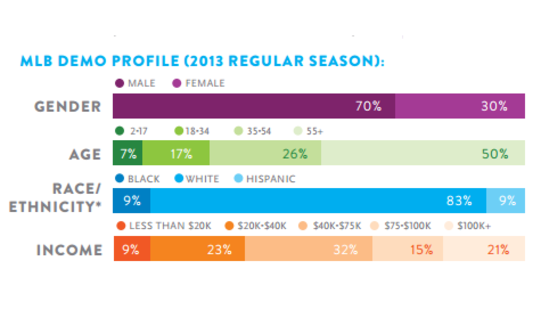Can Social Media Save "Old, White, and Male" Baseball?
As World Series viewership declines, SapientNitro's CMO Bill Kanarick urges baseball to go digital in order to stay relevant to a younger, plugged-in audience.
As World Series viewership declines, SapientNitro's CMO Bill Kanarick urges baseball to go digital in order to stay relevant to a younger, plugged-in audience.
As baseball fans grow older and the sport’s television viewership declines, the key to saving America’s pastime could lie in social media.
So far, this year’s World Series has represented a low point in America’s interest in baseball. With an average of 12.4 million viewers per game, The New York Times reports that viewership of regular season football is almost double that of championship baseball. And not only is football’s audience larger, it’s also more diverse. According to Nielsen’s 2013 Year in Sports report, football appeals to a broad audience of both women and men, old and young, from different ethnic backgrounds, while the average baseball fan is older than 55, white, and male.

 According to Bill Kanarick, senior vice president and chief marketing officer (CMO) of SapientNitro, which recently partnered with the Boston Red Sox to increase the team’s social media presence, for baseball to survive in an increasingly digital world, the sport must adapt to reach to younger audiences more agile with smartphones than baseball bats. The key to earning those young people’s attention lies in keeping up with technology, says Kanarick. “[Baseball] has got to do a lot more with technology and social media. Young people have got technology-based, always-on expectations that look different than your 50-year-old viewer of the World Series. Social is really important because that’s where young people are consuming content.”
According to Bill Kanarick, senior vice president and chief marketing officer (CMO) of SapientNitro, which recently partnered with the Boston Red Sox to increase the team’s social media presence, for baseball to survive in an increasingly digital world, the sport must adapt to reach to younger audiences more agile with smartphones than baseball bats. The key to earning those young people’s attention lies in keeping up with technology, says Kanarick. “[Baseball] has got to do a lot more with technology and social media. Young people have got technology-based, always-on expectations that look different than your 50-year-old viewer of the World Series. Social is really important because that’s where young people are consuming content.”
For example, plugged-in Millennials increasingly expect more tech-savvy stadiums. According to Kanarick, Wi-Fi-enabled stadiums are necessities for younger fans who want to share their sports experiences across social. “Enabling the technology environment is one of the most important things that baseball can be doing,” he says. “You go to sports games and all sorts of traffic congestion is clogging the cellular network. Football’s newer stadiums are doing more to advance the technology experience than has been the case with baseball, and the opportunity for the overlay to leverage technology with what’s happening on the field is a powerful thing.”
Baseball must also expand its fan base online by humanizing players for a younger generation used to easily accessible YouTube celebrities. One example of baseball using social video to make players relatable to a younger audience is Fan Cave, a series of video content sponsored by MLB, featuring players in often-humorous situations, such as the Cleveland Indians’ Corey Kluber auditioning for True Detective or the Oakland A’s Sonny Gray pranking unsuspecting New Yorkers.
A series of videos like those at Fan Cave goes a long way toward humanizing MLB players for younger audiences. While the average baseball fan is in his mid-50s, “The average age of a Fan Cave fan hovers closer to the upper-30s, so there’s a really big difference,” says Kanarick. “Out-of-game content and access to players keeps fans really engaged. Fan Cave has 3 million followers compared to 250,000 just a couple of years ago, so it’s actually made a lot of progress.”
But funny videos aren’t enough to draw in young viewers who are used to tweets, vines, and Reddit AMAs from their favorite celebrities. Baseball players will need to make themselves social media stars if they expect Millennials and beyond to get involved with baseball, he says. “Baseball as a sport is the poorest performer on social media across all the major sports. If you look at the top 50 [athletes] on social media, baseball doesn’t have a single player in the top 50. Baseball’s got to do a lot more with social and mobile for younger fans.”
If baseball wants to stay relevant, the sport must use social and technology to diversify its audience, says Kanarick. “Baseball is old, white, and male. Attracting a more multicultural audience and younger fans is critical to the future of the sport.” He believes that the key to winning a more diverse audience lies in humanizing baseball for fans through social media, and imagines a much more accessible game in the future. “I’d like to see players tweeting from the dugout. Anything that can be done to bring fans closer to the game is great.”
Images via Nielsen and Shutterstock.